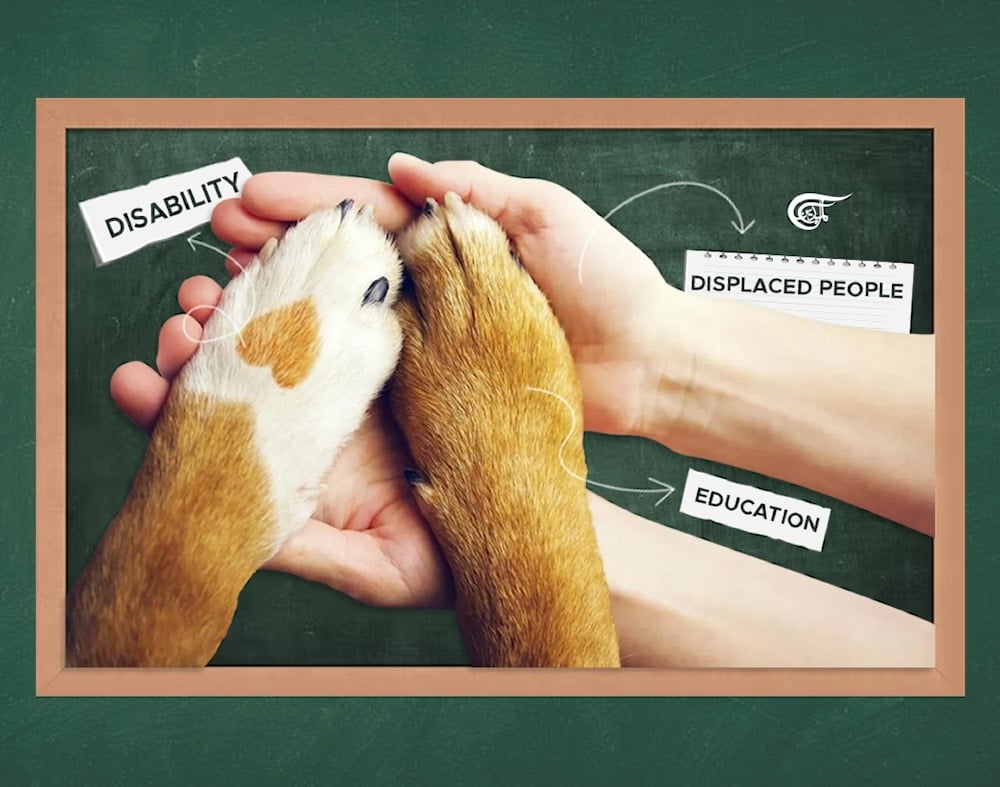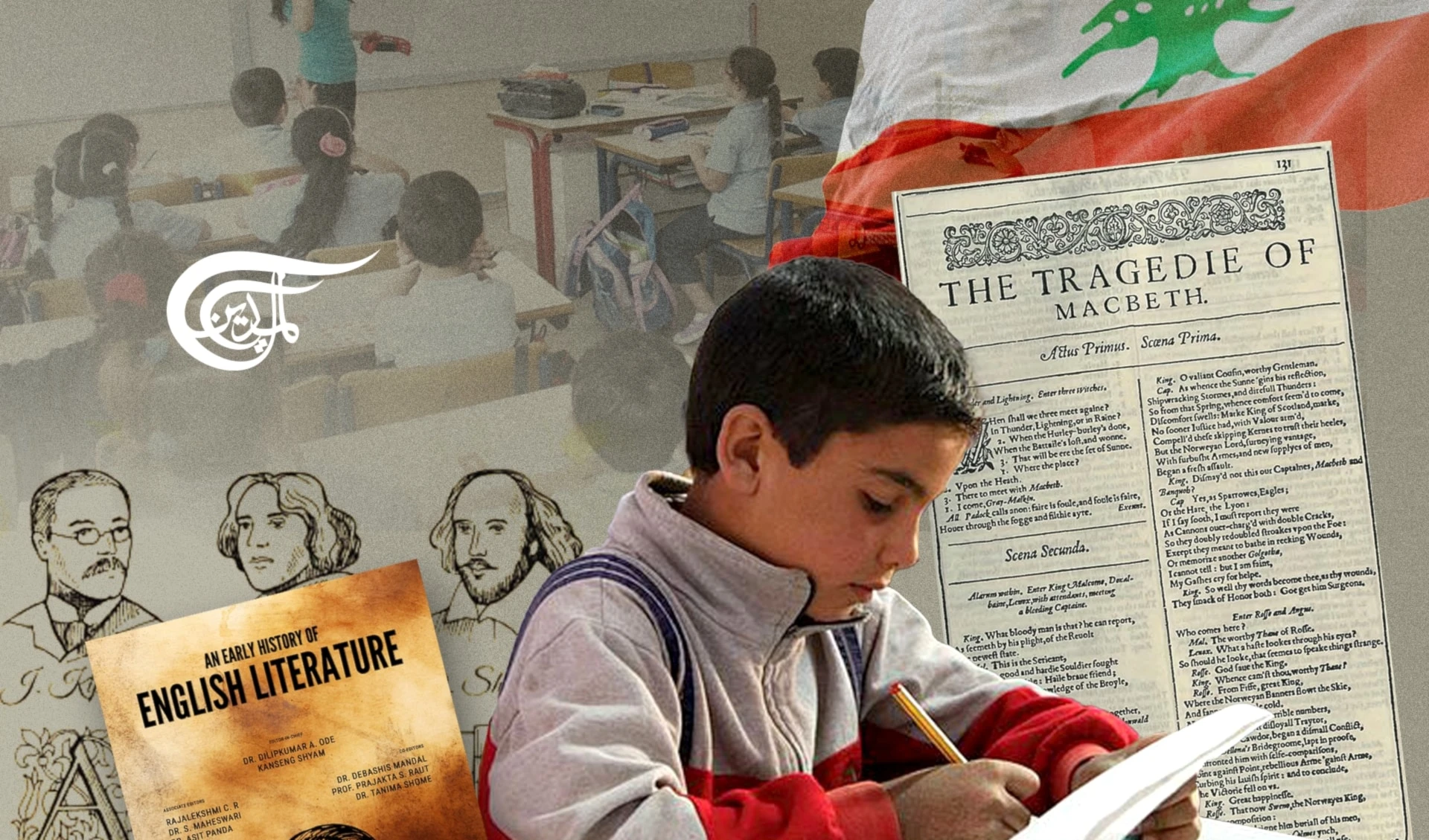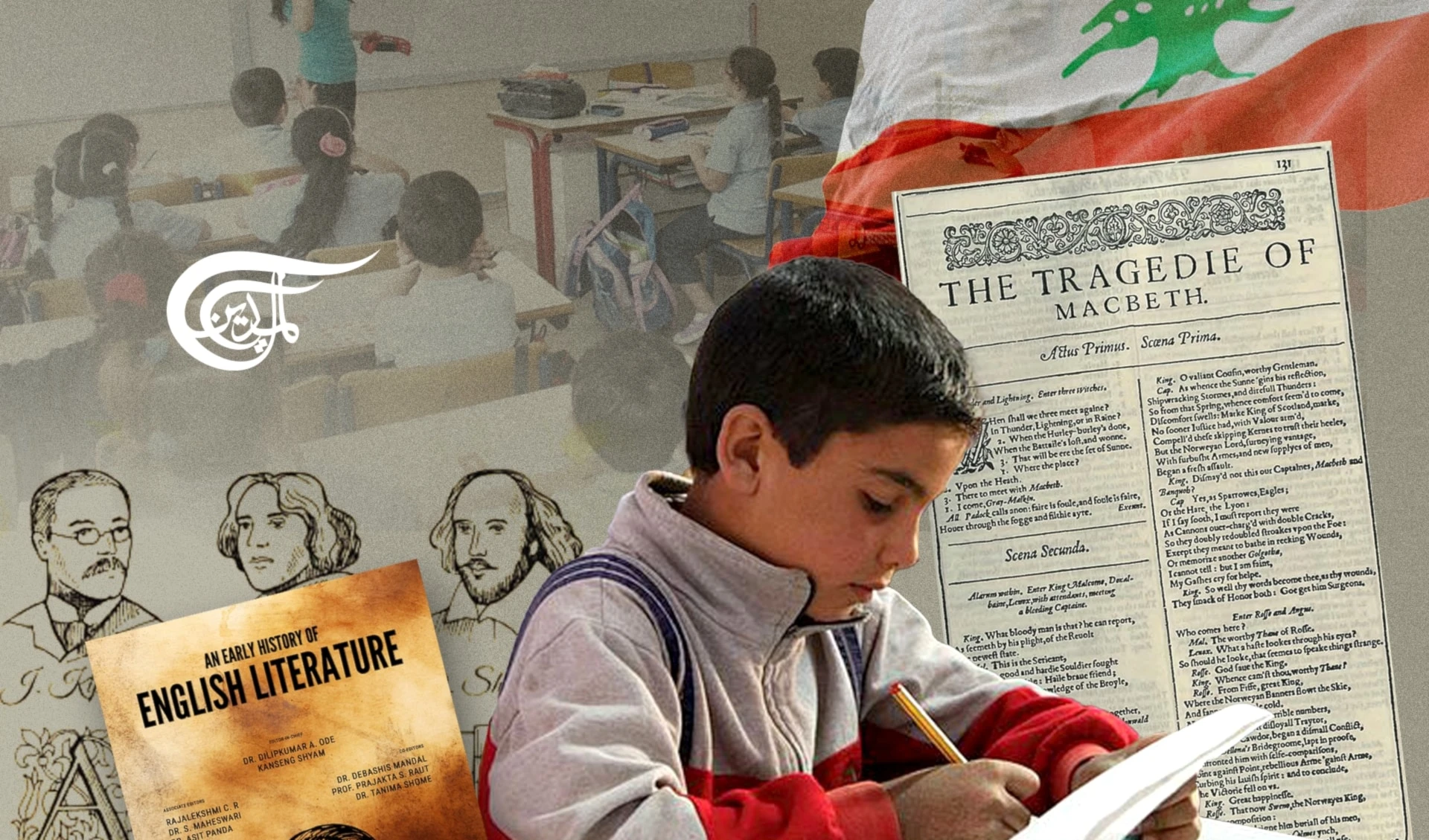The silent therapy: Pets as catalysts for psychological well-being, academic achievement in youth, young adults, and displaced populations
At a time when education faces the compounded challenges of post-pandemic loss, rising anxiety, and global displacement, animal-assisted interventions emerge as cost-effective, ethically sound, and profoundly human strategies.
-

Animals aren’t just pets, they’re teachers too (Illustrated by Zeinab al-Hajj; Al Mayadeen English)
In contemporary educational discourse, the human–animal bond is increasingly apprehended not merely as a matter of sentiment but as a phenomenon with profound pedagogical implications. Animals, whether domestic companions such as dogs and cats, smaller classroom creatures, such as guinea pigs and rabbits, or even larger and agricultural species, such as horses and livestock, function as vital mediators of affective regulation, social engagement, and cognitive growth. For the young child negotiating the uncertainties of early literacy, for the adolescent navigating the pressures of peer conformity, and for the university student burdened by academic and emotional strain, the presence of a companion animal provides an anchoring figure whose non-judgemental stability affords both comfort and courage. In contexts of fragility, such as refugee encampments or the upheaval following a natural disaster, the continuity secured by daily routines of animal care and the embodied familiarity of interspecies bonds can reconstitute a sense of identity and restore the capacity to learn. Structured interactions with animals should therefore not be conceived as auxiliary embellishments, but as central supports for educational well-being, mitigating stress, enhancing executive functioning, and sustaining academic motivation, each of which is indispensable for intellectual development in formative years.
The empirical record substantiates these claims at both psychological and physiological levels, establishing a bridge between affect and cognition. Groenewoud et al. observe in their systematic review that children who form attachments with animals display significantly greater self-esteem and empathy, alongside lower levels of anxiety. Purewal et al. corroborate this in a broader review linking animal companionship with improved behavioural adjustment across youth populations. Kurdek, drawing on attachment theory, confirms that children often invest their pets with psychological functions akin to human attachment figures, drawing emotional security from them in times of stress and finding a stable base from which to explore and to learn. Neurobiological research lends further support: Nagasawa et al. demonstrated that dog–human eye contact elevates oxytocin in both species, reinforcing the bond, while Beetz et al. found that interaction with animals increases dopamine and serotonin and decreases cortisol, neurochemicals that directly regulate attention, emotional stability, and stress management. Taken together, these findings do not simply confirm the comfort of pets but reveal the mechanisms by which animals promote readiness for learning (Groenewoud et al.; Purewal et al.; Kurdek; Nagasawa et al.; Beetz et al.).
Such mechanisms prove especially consequential in postsecondary environments, where the stakes of academic persistence and mental health are particularly high. Pendry et al., in a randomised controlled trial with 309 first-year students, showed that those with prior mental health or learning difficulties improved in affect as well as in executive functions of organisation, planning, and inhibitory control, with gains that persisted six weeks after the programme ended. Binfet and Passmore similarly recorded lower cortisol levels and greater emotional stability among first-year students who participated in canine-assisted stress-relief sessions during midterms (Pendry et al.; Binfet and Passmore). These findings shift the focus from mere comfort to cognitive resilience: animals, by alleviating anxiety, enable students not only to endure academic pressure but to cultivate the executive capacities on which sustained learning depends.
At earlier stages of education, the same pattern of support appears in the domain of literacy. Levinson et al., working with children in grades two through five, compared groups reading aloud to therapy dogs and handlers with those reading to peers, and found that the dog-assisted group demonstrated more substantial gains in oral reading fluency over the five-week intervention, with the most striking advances among the younger participants. Kirnan, Siminerio, and Wong, in two consecutive years of research, reported that children in classrooms with therapy dogs developed more positive attitudes toward reading and that significant literacy improvements were most pronounced in kindergarten and first grade, with English Language Learners benefitting alongside their peers. Hall, Gee, and Mills, reviewing forty-eight studies, synthesised these accounts and concluded that dog-assisted reading programmes reduce anxiety, cultivate motivation, and extend on-task behaviour, particularly for reluctant readers, though they also cautioned that methodological limitations such as small samples and limited controls require more rigorous inquiry (Levinson et al.; Kirnan, Siminerio, and Wong, “Impact”; Kirnan, Siminerio, and Wong, “Two-Year”; Hall, Gee, and Mills).
Lenihan et al. extend this picture by focusing on the subtler, qualitative dimensions of learning. In their study of a five-week R.E.A.D. programme with second graders, they observed that while the small sample size limited statistical power, children in the control group displayed a decline in reading attitudes, whereas those in the dog group remained stable. Teachers reported that children in the intervention exhibited greater confidence, composure, and willingness to persist with challenging passages (Lenihan et al.). These observations matter because they show that the presence of animals can secure the affective conditions, calmness, resilience, and self-assurance, without which literacy acquisition cannot progress.
From literacy, the field broadens to the wider classroom environment. Meints, Brelsford, and Dimolareva conducted controlled trials in both mainstream and special education schools, where children participated in twice-weekly, twenty-minute dog-assisted sessions for four weeks. Cortisol measures revealed that, unlike control groups whose levels rose during the term, children in the intervention group remained stable, and those with special educational needs experienced significant reductions. Teachers further reported that on intervention days, pupils were calmer, more focused, and more receptive to instruction (Meints et al.). The implication is clear: emotional regulation, often invisible yet foundational, is as vital to education as curriculum content, and animals can provide the stabilising presence that sustains it.
The value of animal companionship also emerges in situations of displacement and trauma, where continuity itself becomes a form of pedagogy. Tanaka et al., in their study of Japanese households affected by the 2011 tsunami, found that while pet owners initially reported greater stress due to evacuation burdens, those who retained or re-established animal bonds later exhibited lower PTSD scores, stronger community participation, and smoother school re-entry. Miliutina et al., examining Ukrainian families, observed that more than one-third refused to evacuate unless their pets were accommodated, and that children in households with animals displayed fewer behavioural problems and resumed schooling more readily. Montgomery, Lloyd, and Liang, in a global review, confirmed that forced separation from pets correlates with heightened anxiety, depression, and educational disruption in children (Tanaka et al.; Miliutina et al.; Montgomery, Lloyd, and Liang). Animals, in such contexts, provide the psychological continuity that makes the return to structured learning possible.
The therapeutic reach extends beyond dogs to other species whose modes of interaction broaden the scope of educational support. Dietz et al. demonstrated that children recovering from sexual abuse disclosed more and participated more actively in group therapy when a dog was present. Comparable benefits have been observed with therapy cats, for they have been recognised for their ability to provide emotional support to children in counselling and educational settings, fostering a calming and secure atmosphere that may help them regulate their emotions and encourage engagement, particularly among those who are initially hesitant to interact with unfamiliar adults (Kogan, ed.). Equine programmes provide another dimension. Bachi et al. found that adolescents at risk of disengagement improved in self-efficacy, emotional regulation, and communication through structured equine therapy, with outcomes observable in fewer behavioural referrals and more positive teacher assessments. Stoppard and Donaldson likewise recorded that equine-assisted learning in non-riding contexts enhanced teamwork, communication, and confidence in both primary and secondary pupils. Reviews further indicate reductions in hyperactivity and executive function difficulties, though the field still awaits larger trials (Dietz et al.; Kogan et al.; Bachi et al.; Stoppard and Donaldson). Horses, highly responsive and requiring composure from their handlers, provide immediate feedback, ensuring that lessons in self-regulation are felt rather than merely taught.
Cats and smaller classroom animals provide similar opportunities for relational learning. While most controlled trials centre on dogs, population surveys have consistently linked cat ownership with reduced loneliness and greater well-being in adolescents, with cats offering attachment-based comfort comparable to dogs (Purewal et al.). In early education, animals such as guinea pigs, rabbits, or fish have been shown to foster empathy, cooperative play, and social skills, particularly among children with autism (O’Haire et al.). The practical advantage of these animals lies in their accessibility: they introduce routines of turn-taking and caregiving while avoiding the logistical challenges and allergy-related constraints that canine interventions can sometimes pose.
Beyond the classroom, agricultural animals extend the pedagogical role of animals into vocational and therapeutic settings. The literature on green care demonstrates that farm-based programmes integrating livestock, horticulture, and structured daily tasks improve social inclusion, mental health, and skill acquisition (Sempik, Hine, and Wilcox). For children and adolescents alienated from mainstream education, care farming provides the scaffolding of routine, responsibility, and cooperative labour, supporting re-entry into formal schooling. Feeding, grooming, and monitoring livestock here become more than chores: they are structured lessons in sequencing, persistence, and responsibility, competencies that transfer both to academic readiness and to employability.
Recognition of these benefits has led many universities and schools to institutionalise animal-assisted initiatives. Programmes such as “Paws to Relax” at Yale, the University of British Columbia, and Edinburgh attract hundreds of students during examinations, with surveys showing that between eighty-five and ninety percent of participants report greater calm and focus afterward. These accounts echo Pendry et al.’s findings that structured interaction with animals supports executive functioning, confirming that the academic impact of such programmes is not incidental but substantial.
The sustainability of these interventions, however, rests upon their ethical architecture. De Winkel et al. and Glenk stress that animal welfare is not peripheral but intrinsic to programme success: animals who are overworked, stressed, or mishandled not only suffer themselves but diminish the human benefits sought. Ethical reciprocity is therefore a principle of practice as well as pedagogy, for when students observe that the animals’ well-being is protected with as much care as their own, they learn that empathy and responsibility are conditions of genuine learning. This reciprocity demands institutional commitment. IAHAIO and the American Association of Veterinary Medical Colleges have articulated guidelines that require professional oversight, structured training for handlers and educators, and clear protocols for animal welfare. Only when such frameworks are in place can animal-assisted programmes achieve their promise, functioning not as sentimental supplements but as integral elements of an educational ecology in which well-being, responsibility, and learning are inseparably linked (De Winkel et al.; Glenk; International Association of Human–Animal Interaction Organizations; American Association of Veterinary Medical Colleges).
The extensive research amassed across diverse educational contexts strongly supports the systematic integration of animal-assisted interventions into Lebanon’s schools at all levels. From early literacy classrooms to university stress management programmes, studies consistently demonstrate that structured interaction with animals enhances cognitive engagement, emotional regulation, and social competence, effects that are measurable through both physiological markers such as cortisol and oxytocin and behavioural indices such as task persistence and verbal participation (Beetz et al.; Meints, Brelsford, and Dimolareva; Pendry et al.; Kirnan, Siminerio, and Wong, “Two-Year”). In light of these findings, adopting national frameworks that incorporate therapy dogs, classroom pets, and farm-based programmes into Lebanese curricula could yield significant educational gains, particularly for students facing socio-economic hardship, displacement, or trauma. Implementing such programmes with professional oversight, educator training, and careful attention to animal welfare would create a more resilient, motivated, and emotionally balanced student body, demonstrating the practical value of translating research findings into nationwide educational practice.
To recapitulate, the human–animal bond constitutes not a decorative addition to pedagogy but a mechanism, empirically grounded and ethically necessary, through which psychological well-being and academic achievement are cultivated. Across childhood, adolescence, and young adulthood, in classrooms, universities, and refugee settlements, animals serve as anchors of continuity and catalysts of growth. They sustain literacy, regulate emotion, reduce stress, and fortify motivation, bridging affect and cognition, safety and exploration, routine and resilience. At a time when education faces the compounded challenges of post-pandemic loss, rising anxiety, and global displacement, animal-assisted interventions emerge as cost-effective, ethically sound, and profoundly human strategies for enabling learners not merely to endure but to flourish.
References:
American Association of Veterinary Medical Colleges. Guidelines for the Use of Animals in Veterinary Education. 2022, www.aavmc.org/wp-content/uploads/2023/02/AAVMC-Guidelines-AnimalUse.pdf.
Bachi, Koraly, Joseph Terkel, and Mira Teichman. “Equine-Facilitated Psychotherapy for At-Risk Adolescents: The Influence on Self-Image, Self-Control and Trust.” Clinical Child Psychology and Psychiatry, vol. 17, no. 2, 2012, pp. 298–312. https://doi.org/10.1177/1359104511404177.
Beetz, Andrea, Kerstin Uvnäs-Moberg, Henri Julius, and Kurt Kotrschal. “Psychosocial and Psychophysiological Effects of Human–Animal Interactions: The Possible Role of Oxytocin.” Frontiers in Psychology, vol. 3, 2012, article 234. https://doi.org/10.3389/fpsyg.2012.00234.
Binfet, John Thomas, and Heather A. Passmore. “Hounds and Homesickness: The Effects of an Animal-Assisted Therapeutic Intervention for First-Year University Students.” Anthrozoös, vol. 29, no. 3, 2016, pp. 441–454. https://doi.org/10.1080/08927936.2016.1181364.
De Winkel, Tim, et al. “Observational Behaviors and Emotions to Assess Welfare of Dogs: A Systematic Review.” Journal of Veterinary Behavior, vol. 72, 2024, pp. 1–17. https://doi.org/10.1016/j.jveb.2023.12.007.
Dietz, Tara J., Deborah Davis, and Janice Pennings. “Evaluating Animal-Assisted Therapy in Group Treatment for Child Sexual Abuse.” Journal of Child Sexual Abuse, vol. 21, no. 6, 2012, pp. 665–683. https://doi.org/10.1080/10538712.2012.726700.
Glenk, Lisa Maria. “Current Perspectives on Therapy Dog Welfare in Animal-Assisted Interventions.” Animals, vol. 7, no. 8, 2017, article 58. https://doi.org/10.3390/ani7020007.
Groenewoud, Daan, et al. “Children’s Bond with Companion Animals and Associations with Psychosocial Health: A Systematic Review.” Frontiers in Psychology, vol. 14, 2023, article 1120000. https://doi.org/10.3389/fpsyg.2023.1120000.
Hall, Stephanie S., Nancy R. Gee, and Daniel S. Mills. “Children Reading to Dogs: A Systematic Review of the Literature.” PLOS ONE, vol. 11, no. 2, 2016, e0149759. https://doi.org/10.1371/journal.pone.0149759.
International Association of Human–Animal Interaction Organizations (IAHAIO). IAHAIO White Paper: The IAHAIO Definitions for Animal-Assisted Intervention and Guidelines for Wellness of Animals Involved. 2020, https://iahaio.org/wp/wp-content/uploads/2020/07/iahaio_wp_updated-2020-aai-adjust-1.pdf.
Kirnan, Jean, Steven Siminerio, and Zachary Wong. “The Impact of a Therapy Dog Programme on Children’s Reading Skills and Attitudes Toward Reading.” Early Childhood Education Journal, vol. 44, no. 6, 2016, pp. 637–651. https://doi.org/10.1007/s10643-015-0747-9.
Kirnan, Jean, Steven Siminerio, and Zachary Wong. “The Impact of a Therapy Dog Program on Children’s Reading Skills and Attitudes: Two-Year Follow-Up.” Early Childhood Education Journal, vol. 45, no. 3, 2017, pp. 329–338. Springer, https://doi.org/10.1007/s10643-017-0844-z.
Kogan, Lori R., editor. The Impact of Therapy and Pet Animals on Human Stress. CABI Publishing, 2024.
Kurdek, Lawrence A. “Pet Dogs as Attachment Figures.” Journal of Social and Personal Relationships, vol. 26, no. 2–3, 2009, pp. 247–266. https://doi.org/10.1177/0265407507087958.
Lenihan, Declan, et al. “Measuring the Effects of Reading Assistance Dogs on Reading Ability and Attitudes in Elementary Schoolchildren.” Journal of Research in Childhood Education, vol. 30, no. 2, 2016, pp. 252–259. https://doi.org/10.1080/02568543.2016.1143896.
Levinson, Elizabeth M., et al. “Effects of Reading with Adult Tutor/Therapy Dog Teams on Elementary Students’ Reading Achievement and Attitudes.” Society & Animals, vol. 25, no. 1, 2017, pp. 38–56. https://doi.org/10.1163/15685306-12341427.
Meints, Kerstin, Nicola Brelsford, and Ekaterina Dimolareva. “Can Dogs Reduce Stress Levels in School Children? Effects of Dog-Assisted Interventions on Salivary Cortisol in Children with and without Special Educational Needs Using Randomised Controlled Trials.” PLOS ONE, vol. 17, no. 6, 2022, e0269333. https://doi.org/10.1371/journal.pone.0269333.
Miliutina, Kateryna, et al. “The Role of Pets in Preserving the Emotional and Spiritual Wellbeing of Ukrainian Residents during Russian Hostilities.” Journal of Religion and Health, vol. 62, no. 1, 2022, pp. 500–509. https://doi.org/10.1007/s10943-022-01669-4.
Montgomery, Jennifer, Zhi Liang, and Jessica Lloyd. “A Scoping Review of Forced Separation Between People and Their Companion Animals.” Anthrozoös, vol. 37, no. 2, 2024, pp. 245–267. https://doi.org/10.1080/08927936.2023.2287315.
Nagasawa, Miho, et al. “Social Evolution: Oxytocin-Gaze Positive Loop and the Coevolution of Human–Dog Bonds.” Science, vol. 348, no. 6232, 2015, pp. 333–336. https://doi.org/10.1126/science.1261022.
O’Haire, Marguerite E., et al. “Social Behaviours Increase in Children with Autism in the Presence of Animals Compared to Toys.” PLOS ONE, vol. 8, no. 2, 2013, e57010. https://doi.org/10.1371/journal.pone.0057010.
Pendry, Patricia, et al. “Incorporating Human–Animal Interaction into Academic Stress Management Programmes: Effects on Typical and At-Risk College Students’ Executive Function.” AERA Open, vol. 7, 2021. https://doi.org/10.1177/23328584211011612.
Purewal, Radhika, et al. “Companion Animals and Child/Adolescent Development: A Systematic Review of the Evidence.” International Journal of Environmental Research and Public Health, vol. 14, no. 3, 2017, article 234. https://doi.org/10.3390/ijerph14030234.
Sempik, Joe, Rachel Hine, and Deborah Wilcox, editors. Green Care: A Conceptual Framework: A Report of the Working Group on the Health Benefits of Green Care. COST Action 866, Green Care in Agriculture, Loughborough University, 2010, GreenCare.at, PDF file, https://www.greencare.at/publikation/green-care-a-conceptual-framework-a-report-of-the-working-group-on-the-health-benefits-of-green-care/.
Stoppard, Lucy, and Laura Donaldson. “Evaluation of Equine-Assisted Learning in Education for Primary School Children: A Qualitative Study of the Perspectives of Teachers.” Frontiers in Education, vol. 9, 2024, article 1275280. https://doi.org/10.3389/feduc.2024.1275280.
Tanaka, Akihiro, et al. “Effect of Pets on Human Behaviour and Stress in Disaster.” Frontiers in Veterinary Science, vol. 6, 2019, article 113. https://doi.org/10.3389/fvets.2019.00113.

 Dana Kahil
Dana Kahil
 17 Min Read
17 Min Read











